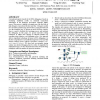Free Online Productivity Tools
i2Speak
i2Symbol
i2OCR
iTex2Img
iWeb2Print
iWeb2Shot
i2Type
iPdf2Split
iPdf2Merge
i2Bopomofo
i2Arabic
i2Style
i2Image
i2PDF
iLatex2Rtf
Sci2ools
DAC
2003
ACM
2003
ACM
Advanced techniques for RTL debugging
Conventional register transfer level (RTL) debugging is based on overlaying simulation results on structural connectivity information of the Hardware Description Language (HDL) source. This process is helpful in locating errors but does little to help designers reason about the how and why. Designers usually have to build a mental image of how data is propagated and used over the simulation run. As designs get more and more complex, there is a need to facilitate this reasoning process, and automate the debugging. In this paper, we present innovative debug techniques to address this shortage in adequate facilities for reasoning about behavior, and debugging errors. Our approach delivers significant technology advances in RTL debugging; it is the first comprehensive and methodical approach of its kind that extracts, analyzes, traces, explores, and queries a design’s multicycle temporal behavior. We show how our automatic tracing scheme can shorten debugging time by orders of magnitude...
| Added | 05 Jul 2010 |
| Updated | 05 Jul 2010 |
| Type | Conference |
| Year | 2003 |
| Where | DAC |
| Authors | Yu-Chin Hsu, Bassam Tabbara, Yirng-An Chen, Fur-Shing Tsai |
Comments (0)

